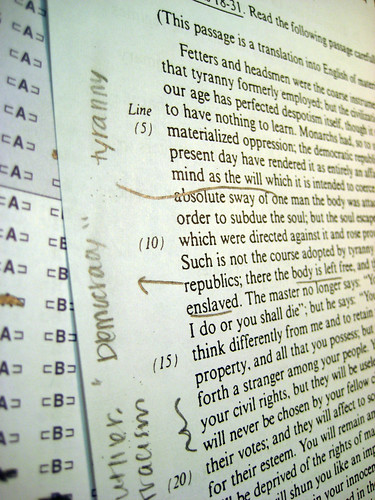It might not mean much, but as I was recording some scores in my gradebook today, I noticed the difference between my students who annotated versus those who didn't annotate a sample AP English Language multiple choice passage. Out of the 65 students who took the test, 33 of them annotated but 32 didn't. The people who annotated the passage scored on average 9% higher than the students who didn't. I always encourage the students to read with a pencil in hand, but it's not a requirement; now I'm rethinking that. The image on the right is of a student of mine who had a perfect score, and I couldn't help but notice the rich annotation on the passage (arrows, summary, brackets, quoted materials). I haven't had the time yet to do more than a cursory view of the research on the effect of annotation on reading comprehension, so this could just be a coincidence.
And even if it isn't an isolated phenomenon, we all know that correlation isn't causation. Maybe annotation makes more effective readers, or maybe more effective readers annotate. Still, it does make me wonder....
Thursday, January 31, 2013
Wednesday, January 23, 2013
Writing connected research
 |
| Adventure by Ben Harvey |
Is their writing that's done for the screen better than their writing for paper, or vice-versa? I don't know. But what I do know is that I need to prepare my students for both types of composition, at least for the immediate future. And I also know that students now need to understand how to access and assess information from a lot of different sources. For example, some of these databases and resources I use are open; others are locked behind paywalls or only accessible through library subscriptions (more on that later).
If you're interested in doing this yourself, here is some information about the resources and databases the students use as they blog and discuss their findings:
- Read some Opposing Viewpoints about a current political issue.
- Using the date range advanced search feature in Google, read recent news articles written about your topic.
- Search using the Gale database available through our school library.
- Search the EBSCO database, available to all students in our state.
- Use the Google top-level site operator, read the different types of information available through .org .edu .mil .gov .info etc.
- Interview experts with extensive knowledge of your topic.
- Search Twitter and blogs for real-time information. For this and all posts do the assessing credibility exercise
Friday, January 18, 2013
Connected research and social scholarship
As my seniors work through a research writing unit in my English class, the ideas of connected research and social scholarship become more apparent.
For me connected research refers to the many interactions my students have, not only with each other through shared docs and such, but also to their direct communication with "experts." Even in my pre-digital classroom, I'd have students interview experts, so that much isn't really new. But seems different now is the rate of response the students are getting from knowledgeable people via a variety of channels. Increasingly, my students are finding that their chosen experts connect primarily through one channel: Facebook, Twitter, email, etc. And when my students finally track down the expert and their preferred method of contact, the response rate has been greater than in the past.
 |
| Ball o' fire by Reid Bell |
This reminds me of a conversation I had with a retiring biochemical researcher who'd received countless competitive grants in his career. He said that when he first began as a researcher, the important thing in obtaining funds was the ready access to state-of-the-art labs and a cohesive research team. But now what he's seeing is that the big research grants are going to those people who collaborate by sharing the resources of labs located around the world while assembling a team of people with diverse perspectives. The idea was reinforced when I started coming across articles like "Science 2.0" and more recently in books like Dan Tapscott's Macrowikinomics.
In Social Scholarship: Applying Social Networking Technologies to Research Practices, the Computer Research Association states that "fewer individuals will be able to carry out their work without connecting with their peers, experts, and mentors via electronic networks."
A similar sentiment is echoed in the Horizon Report's 2012 Higher Education wiki on New Scholarship: "Increasingly, scholars are beginning to employ methods unavailable to their counterparts of several years ago, including prepublication releases of their work, distribution through non-traditional channels, dynamic visualization of data and results, and new ways to conduct peer reviews using online collaboration. New forms of scholarship, including creative models of publication and non-traditional scholarly products, are evolving along with the changing process. Some of these forms are very common — blogs and video clips, for instance — but academia has been slow to recognize and accept them. Proponents of these new forms argue that they serve a different purpose than traditional writing and research — a purpose that improves, rather than runs counter to, other kinds of scholarly work."
I suppose this is all just a subset of what's meant by connected learning. And maybe I'm just more aware of it now, but I'm seeing more connected methodologies manifest themselves in the digital and traditional writing my students compose now.
I suppose this is all just a subset of what's meant by connected learning. And maybe I'm just more aware of it now, but I'm seeing more connected methodologies manifest themselves in the digital and traditional writing my students compose now.
Subscribe to:
Posts (Atom)
